You-Pick Apples
Apple Picking
Check back for apple updates! We offer apple picking during our fall season every day, 9am to 6:30pm (or sunset), or 5:15pm September Saturdays and Sundays.
Vala’s now has the largest apple orchard in Nebraska, with over 40 acres of apples, including 45 varieties throughout the fall season!
Our orchard is planted on a modern trellis system, making it easy for guests of all ages to reach and easily pick an apple. Throughout our growing season, we offer classic apple varieties such as Honeycrisp and Jonathan, as well as new, unique varieties like Ludacrisp and Sweet Zinger! Either way, there is absolutely nothing like an apple picked fresh from the tree.
As you enter Vala’s, head towards our new Cider Mill, where you will load on a tractor ride at the U-Pick Apple Shed. Purchase anything from a ½ peck bag to a full bushel basket to pick apples from our beautiful, expansive orchard. Guests must purchase a bag of apples to ride out to the orchard, with bag prices starting at $12.99 for a ½ peck (about 5 lbs). Guests may have up to 4 people picking per ½ peck bag. Allow approximately 30-45 minutes for this experience.
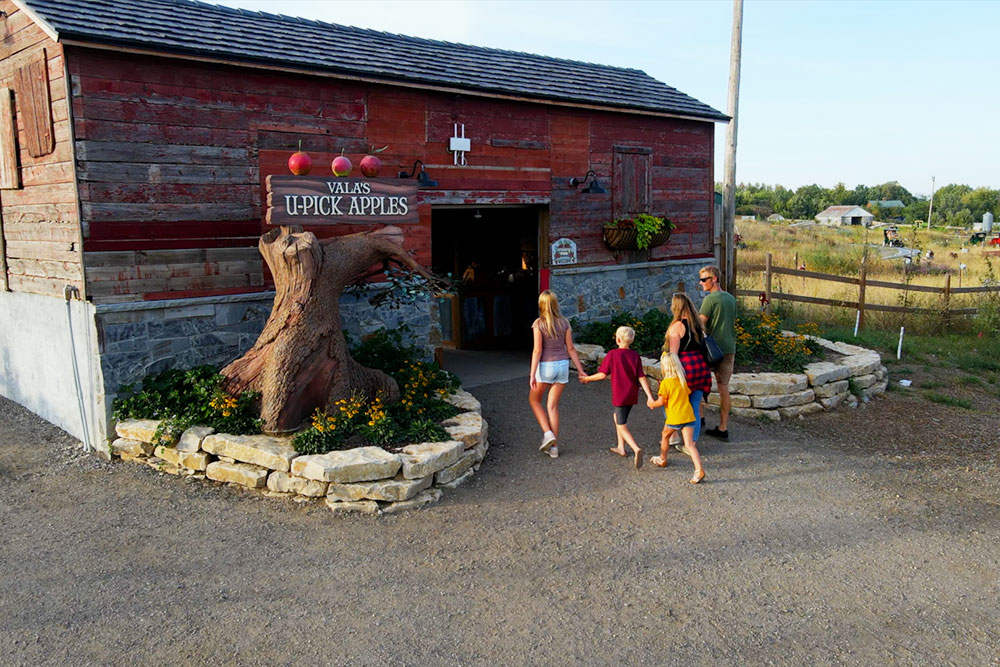


At Vala’s, we also grow over 7 acres of heirloom apples, specifically for our ciders.
These are bittersweet and bittersharp apples, such as Franklin, Harrison, Golden Russet, Northern Spy, and Kingston Black. While they may not be the best apples for eating, they are some of the best for drinking! We press our own apples into sweet and hard cider in the Cider Mill, available exclusively at Vala’s.
Now Picking
Now Picking
Evercrisp

Now Picking
Braeburn

Now Picking
Fuji

For Sale in Exit Barn
Pink Lady

For Sale in Exit Barn
Granny Smith

Apple Varieties

GALA
- Early September
- ORIGIN: New Zealand, 1920s
- PROFILE: We’ve all seen Gala in the grocery store, but a Gala fresh from the orchard can be an unforgettable experience. This apple, a cross between Kidd’s Orange Red and Golden Delicious apple varieties, is a wonderful pinkish-red, with orange and yellow stripes. They have a wonderful strawberry sweetness with a touch of soft acid, though with storage, the acidity will start to decline.
- USES: Fresh eating, pies, cider, or dried.

SMOKEHOUSE
- Mid-September
- ORIGIN: Lancaster County, PA, early 1800s
- PROFILE: This antique variety of apple is green and squat with a rusty red blush on the side of the apple that faced the sun in the orchard. It’s firm, dense and very sweet, which makes it optimal for cooking, as its sugars caramelize very easily without being overpowered with tartness.
- USES: Pies, crisps, baking, cider. Fresh eating when straight from the orchard.

MUTSU
- Mid-September
- ORIGIN: Japan, 1937
- PROFILE: Mutsu, also known as Crispin in the U.S., is a cross between a Golden Delicious and an Indo apple, and has the same parentage as Shizuka, but is more tart. It’s a large apple with a uniform soft green color that’s not as vibrant and glossy as a Granny. It’s really delicious when baked, and it won’t take many of these colossal babies to make a pie.
- USES: Fresh eating, pies, baking.

AUTUMN CRISP
- Mid-September
- ORIGIN: Geneva, New York, 2009
- PROFILE: Autumn Crisp is a newer variety of apple on the market, and we believe it will become popular in our orchard very quickly! It’s a cross between a Golden Delicious and a Monroe apple, with a beautiful pink skin that has a touch of faded yellow on the top and bottom. It has a gently sweet and tart flavor with a watery, explosive crunch, similar to that of a Honeycrisp apple. The white flesh – which is so crisp and juicy – seems to instantly dissolve in your mouth like cotton candy.
- USES: Fresh eating (trust me, you’ll want to), salads (slow to brown), cider.
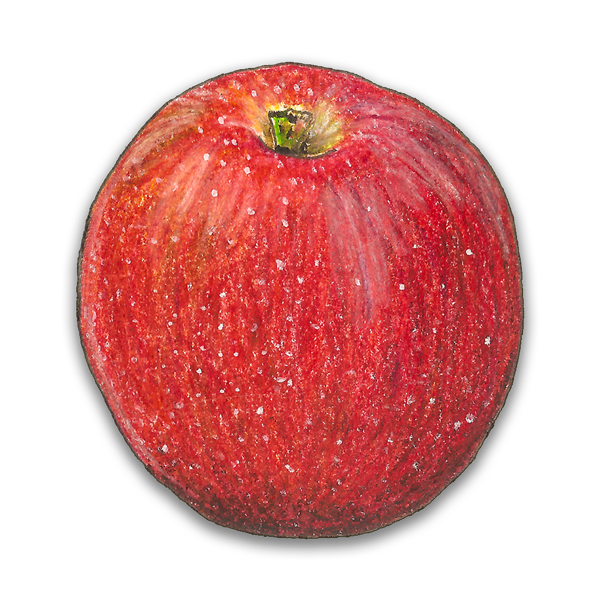
CRIMSON CRISP
- Mid-September
- ORIGIN: New Jersey, 2004
- PROFILE: As this name might suggest, this apple takes on a deep crimson color. It has a crisp, yellow flesh with mild acid, and a sweet, rich note.
- USES: Fresh eating. Stores well under refrigeration.

SHIZUKA
- Mid-September
- ORIGIN: Japan, early 1900s
- PROFILE: Shizuka is not only a fun word to say, but also a very fun apple to eat! It’s very large, firm and juicy. It’s a cross between our beloved Golden Delicious and an Indo apple, and has the same parentage as Mutsu, but is sweeter and has less acid than Mutsu. Look for it’s golden-green color in the orchard.
- USES: Fresh eating, salads (browns slowly). Stores well under refrigeration.

WINECRISP
- Mid-September
- ORIGIN: PRI (Universities of Purdue, Rutgers and Illinois), 1990
- PROFILE: This apple should not be confused with Winesap (as I have done). Its parentage includes Cox’s Orange Pippin, Newtown Pippin, Jonathan, Red Rome, and others. This is a very good quality apple, with a whisper of tartness, some sweetness, and a cream colored, crisp flesh.
- USES: Fresh eating. Stores well under refrigeration.

GOLDEN DELICIOUS
- Mid-September
- ORIGIN: West Virginia, 1890
- PROFILE: The Golden Delicious apple is completely unrelated to Red Delicious, and in fact, it’s parentage is unknown. It’s tender, pale yellow skin is dotted with tiny freckles. Sometimes there is a pale blush on one cheek that faced the sun in the orchard. It has a firm, crisp and juicy flesh that’s sweet with a trace of subtle tartness. It also has a unique fragrant, honey-like aroma. All-in-all, it’s just a good apple.
- USES: A great all-purpose apple! Use in baking, sauces, or for fresh eating. It’s one of my favorite apples to use in pies when it’s fresh from the orchard.

JONAGOLD
- Mid-September
- ORIGIN: Geneva, New York, 1968
PROFILE: Jonagold is actually one of the most popular apples in Europe, even though it hasn’t taken off in the same way in the U.S. It’s a cross between Jonathan and Golden Delicious, and in some ways it resembles both. While it has the honey-like aromatics of a Golden Delicious, it is red like Jonathan with a touch of golden-yellow hue to its skin. It’s a pleasant balance of sweet and sour, and is crisp and juicy when fresh.
- USES: A great all-purpose apple. Makes a great pie! It holds its shape when baked, and is excellent dried.
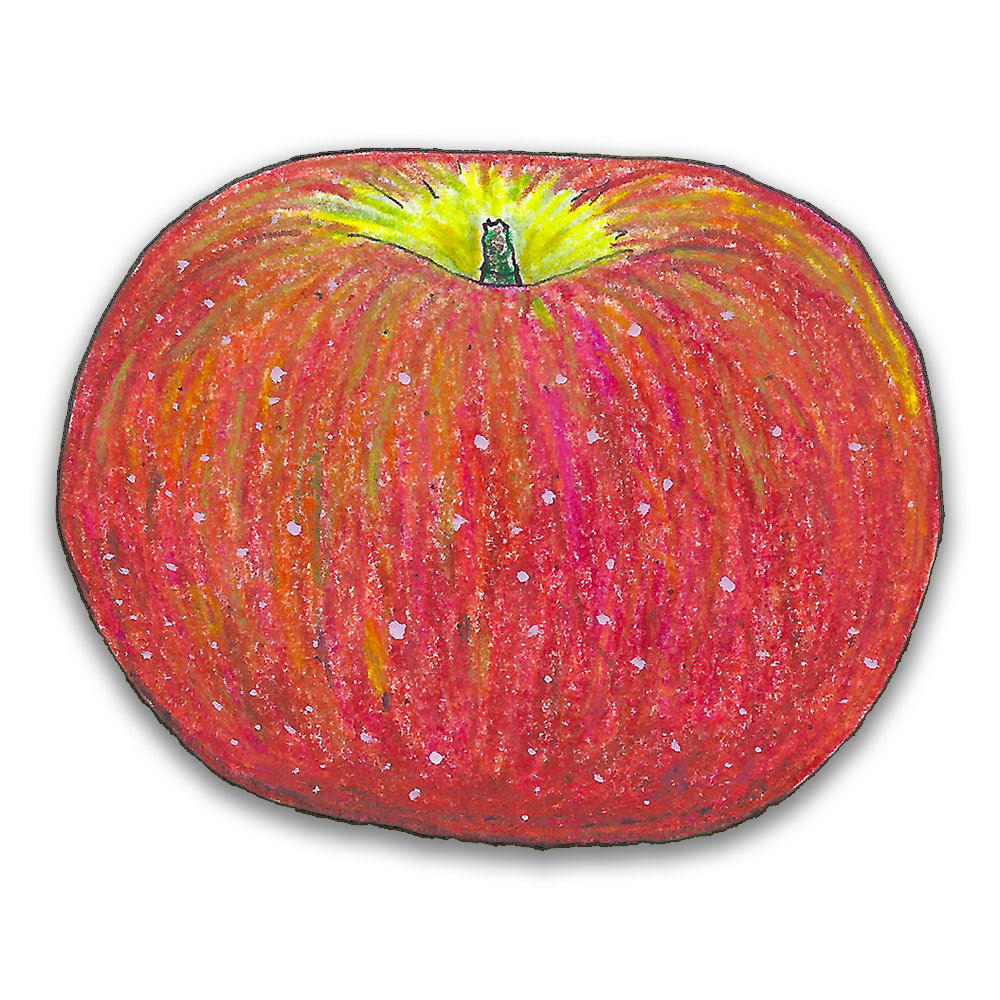
CORTLAND
- Mid-September
- ORIGIN: Geneva, New York, 1898
- PROFILE: Cortland is a cross between Ben David and McIntosh apples. It has a stunningly paper-white flesh, and its color can be shades of green-yellow with a pale red blush spreading around the middle. It has a very elegant, tart flavor that isn’t overwhelmingly sour, and has a juiciness that can run down your chin.
- USES: Use wherever you’d like a little tartness! A great all-purpose apple for fresh eating, pies, salad (browns slowly), cider, and applesauce.

JONATHAN
- Mid-September
- ORIGIN: From the farm of Philip Rick, Woodstock, New York, 1790s
- PROFILE: Ah Jonathan, the apple of my childhood. There is something about the flavor that is distinctly…appley. No, really. It has the flavor of concentrated appley goodness in every bite. It’s mostly sweet, with just a tinge of tartness that keeps it balanced. That’s why for years it’s been the apple of choice for our caramel apples at Vala’s, though now, around mid-October we have to switch to a different variety as our beloved Jonathans start to soften. We have selected two varieties of Jonathan for our orchard, called Ultra Red and Ruby. They are medium-sized, round shape, and a nice deep red with a yellow background glow. Its parent apple is called Esopus Spitzenburg, said to be a favorite of Thomas Jefferson’s.
- USES: Fresh eating by the bushel, pies, applesauce, cider, and caramel apples. A word of warning that Jonathan does not keep well long-term, and tends to get soft as the fall season progresses.

HONEYCRISP
- Mid-September
- ORIGIN: St. Paul, Minnesota, 1991
- PROFILE: This prized apple in our orchard is even better and sweeter than its grocery store counterpart! Honeycrisp has a yellow or light green background color with red stripes and a pink flush. The taste is simple: sweet with just a little tartness that makes you want another bite. The real characteristic that sets Honeycrisp apart is its texture. It has a very crisp texture without being too firm; the type of crisp, juicy texture you’d expect from watermelon, where the soft juicy cells burst and sweet liquid often runs down your arm. Its texture is surprisingly unlike many other apples, and is the reason it’s become so popular.
- USES: Eat fresh and enjoy. Also makes a great pie!
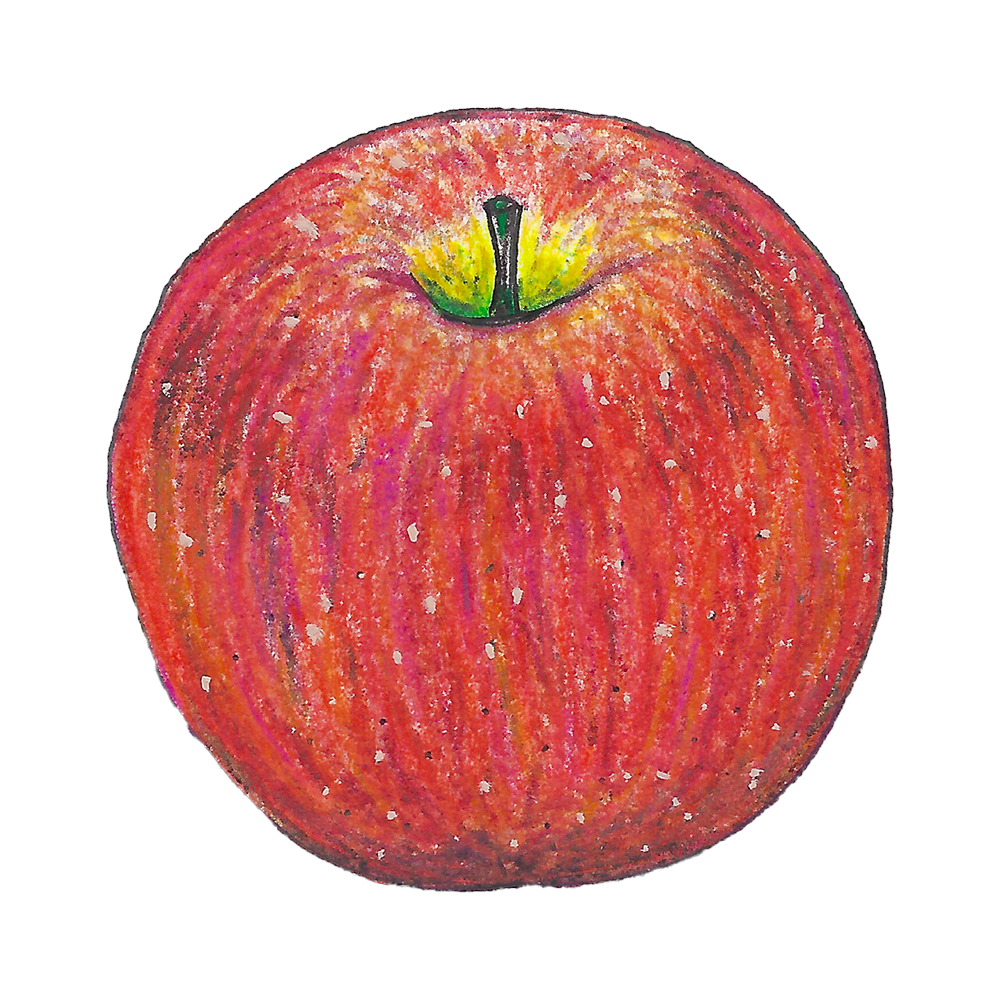
FUJI
- Wonder Fuji Mid-September / Aztec Fuji Mid-October
- ORIGIN: Fujisaki, Japan, 1939
- PROFILE: Even though Fuji originated in Japan, it’s parent apples, Ralls Janet and Red Delicious, have deep roots in American history. Fuji has some beautiful pale red and orange stripes with white freckles. It has a unique sweet and aromatic flavor, and can be very crisp and juicy.
- USES: Fresh eating, dried, pies. Stores well under refrigeration.

PIXIE CRUNCH
- Mid-September
- ORIGIN: Lafayette, Indiana, 1978 (but wasn’t named and released until 2004)
- PROFILE: Pixie Crunch is an adorable name for an adorable apple. It’s a red, round, and super cute little guy. Its flavor is sweet and rich, with the crunch of a Honeycrisp. Perfect for the kiddos.
- USES: School lunch box snack. Does not store well long-term.

EMPIRE
- Late-September/Early October
- ORIGIN: Geneva, New York, 1966
PROFILE: A cross between McIntosh and Red Delicious, Empire has a more vibrant redness and developed flavor than either of its parent apples. Empire is small, round, shiny, and can be a deep red to almost maroon color. It has a juicy, soft texture and the flavor of sweet honey.
- USES: Best when eaten fresh from the orchard. Caramel apples, cider. Can soften if not stored under refrigeration.

IDARED
- Mid-October
- ORIGIN: Idaho, 1942
- PROFILE: Idared (pronounced “Ida Red,” not “I Dared”), is a cross between a Jonathan and a Wagener apple. It’s a beautiful lipstick red, and offers a tart and aromatic flavor that’s just sweet enough with a soft astringency. They are tart, but they lose some of their tartness in storage.
- USES: Eating fresh, pies, sauces, apple butter, dried.

BRAEBURN
- Mid-October
- ORIGIN: Waiwhero, New Zealand, 1952
- PROFILE: Braeburn is a multi-colored apple with streaks of orange and red on a yellow background, that turns to deep red with white freckles on one cheek. Braeburn was an important commercial variety of apple, because it marked a time when flavor trumped the appearance of monochromatic red and green apples in the grocery store. It’s sweet, tart, and crisp, just the way an apple should be.
- USES: Fresh eating. Stores well under refrigeration.

EVERCRISP
- Mid-October
- ORIGIN: Developed by the Midwest Apple Improvement Association, 2012
- PROFILE: This newer apple variety on the market is a favorite among our orchard crew! Though it looks and tastes similar to a Fuji or a Jonathan, it shares the same bursting, crunchy dense texture of a Honeycrisp. The creamy colored flesh is firm but juicy and very sweet.
- USES: Fresh eating. Stores well under refrigeration.

RED DELICIOUS
- Mid-October
- ORIGIN: Peru, Iowa, 1881
- PROFILE: The Red Delicious apple: the contentious symbol of an American apple, ubiquitous in the marketplace, and the official apple of school lunchboxes and cafeterias. This dark red, handsome apple with a 5-point star on the bottom is what most people know of as an apple. As is typical for a Red Delicious, it has a thick, slightly bitter skin, yellow juicy flesh, and a watery sweetness with little to no tartness. Luckily for us, this apple tastes so much better than it’s supermarket counterparts when picked fresh from the orchard! Otherwise, it can be bland when it’s not fresh. Many would be surprised to find that Red Delicious actually originated in Iowa, discovered as a chance seedling by Jesse Hiatt who originally named it the Hawkeye (but, of course). It is now mostly grown in Washington state.
- USES: Fresh eating only! Does not store well long-term.

GRANNY SMITH
- Mid-October
- ORIGIN: Australia, 1868
- PROFILE: We all know Granny Smith as the glossy bright green apple with cute, white freckles. What you might not know is that this apple was discovered by an older woman named Maria Ann Smith (aka Granny Smith) who found an apple tree growing where she had years before thrown away some rotten French crabapples. Thus, the Granny Smith apple was born. The flavor is tart with an almost under-ripe green flavor, which mellows and sweetens as it matures on the tree and starts turning a paler yellow. These apples are for those who love a puckering crunch.
- USES: Eat fresh if you love tart apples. Sprinkle a slice with a touch of sea salt to balance the acidity. Great for pies and baking!

CAMEO
- Mid-October
- ORIGIN: Washington State, 1987
- PROFILE: Cameo is a rather new variety of apple that was found as a chance seedling in a Red Delicious orchard, so it seems likely that Red Delicious is it’s parent apple. Indeed, it tastes like a better, more flavorful Red Delicious.
- USES: Fresh eating and salads.

PINK LADY
- Mid-October
- ORIGIN: Western Australia, 1973
- PROFILE: Pink Lady carries with it a feminine beauty and delicate flavor. A Pink Lady is oblong and tall with a rosy blush spread over pale yellow skin and small freckles. It is sweet with tropical notes of mango and pineapple and a balanced acidity. It is crisp and firm and just plain good to eat.
- USES: Cider, fresh eating, salads, nice in pies since it can hold its shape, but should be mixed with another
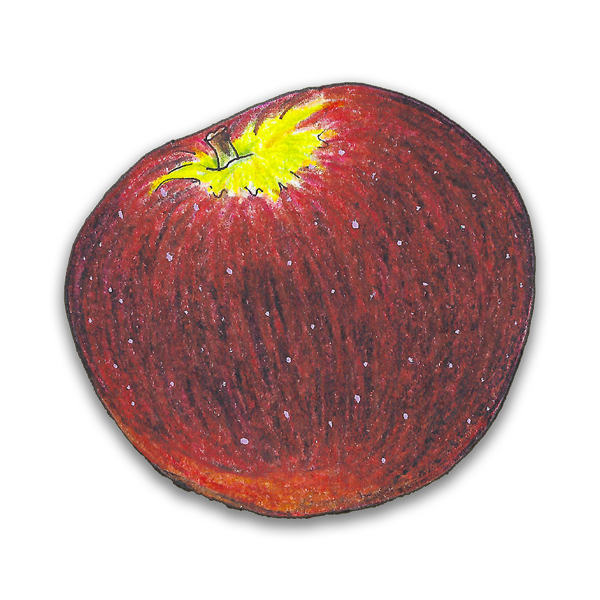
LIBERTY
- Mid-October
- ORIGIN: Geneva, New York, 1978
- PROFILE: Liberty is the cross between a Macoun and an experimental apple variety. It’s a deep red color with an almost white flesh. Liberties are sharp, refreshing, and aromatic with a distinctive vinous note.
- USES: Eating fresh. Stores well under refrigeration.

WINESAP
- Mid-October
- ORIGIN: New Jersey, late 1700s
- PROFILE: A small, tart heirloom variety of apple, Winesap used to be the number one selling apple in America through WWII because of its natural keeping abilities. Then, controlled atmosphere storage became a thing, and knocked Winesap out of first place. It’s sweet, tangy, firm, and astringent. It has a characteristic vinous flavor and aroma. Even if you’re not a fan of its tart flavor for fresh eating, this apple really stands out in baked goods and cider.
- USES: Fresh eating, amazing pies, crisps, cider, sauce. Stores well under refrigeration, though it mellows in flavor.

GOLDRUSH
- Mid-October
- ORIGIN: West Lafayette, Indiana, 1994
- PROFILE: GoldRush is quickly gaining popularity as an exceptionally sweet, tart, spicy, and aromatic variety. It’s firm and juicy with a phenomenal crunch. It’s become a favorite of some of our orchard crew, because it’s one of the most unique apple experiences we’ve encountered! GoldRush is a seedling of a Golden Delicious, so it has many of its parent’s qualities, but is sweeter and more tart. It’s a beautiful apple, in an imperfect sort of way. Pale green gives way to yellow-golden colors and a gentle russeting on top. And sometimes a rusty red color develops on one side where the apple saw the sun in the orchard. Its colors are reminiscent of a turning fall leaf.
- USES: Endless. Cider, pies, salads, devouring. Stores well under refrigeration, so grab a bushel for the winter.
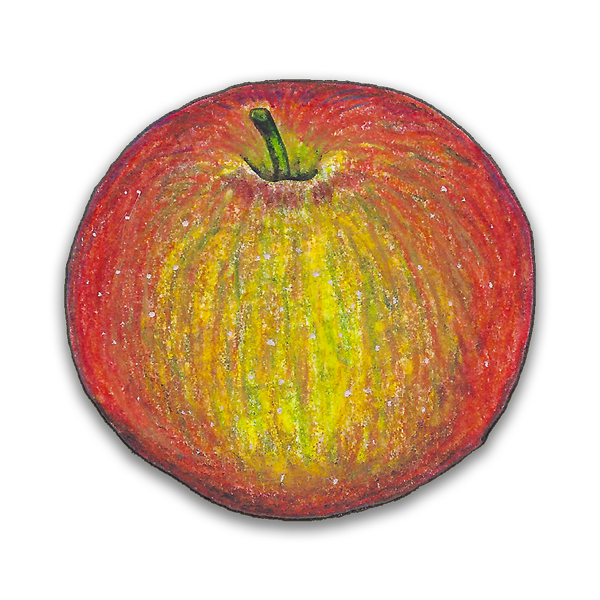
STAYMAN
- Mid-October
- ORIGIN: Leavenworth, Kansas, 1866
- PROFILE: Believed to be the seedling of a Winesap, this old American variety is tart, firm, and vinous. It’s crimson red with light russeting in the stem cavity, making it reminiscent of an old, antique barn.
- USES: Fresh eating for tart apple lovers. Pies, cooking, cider, drying. Stores well under refrigeration.
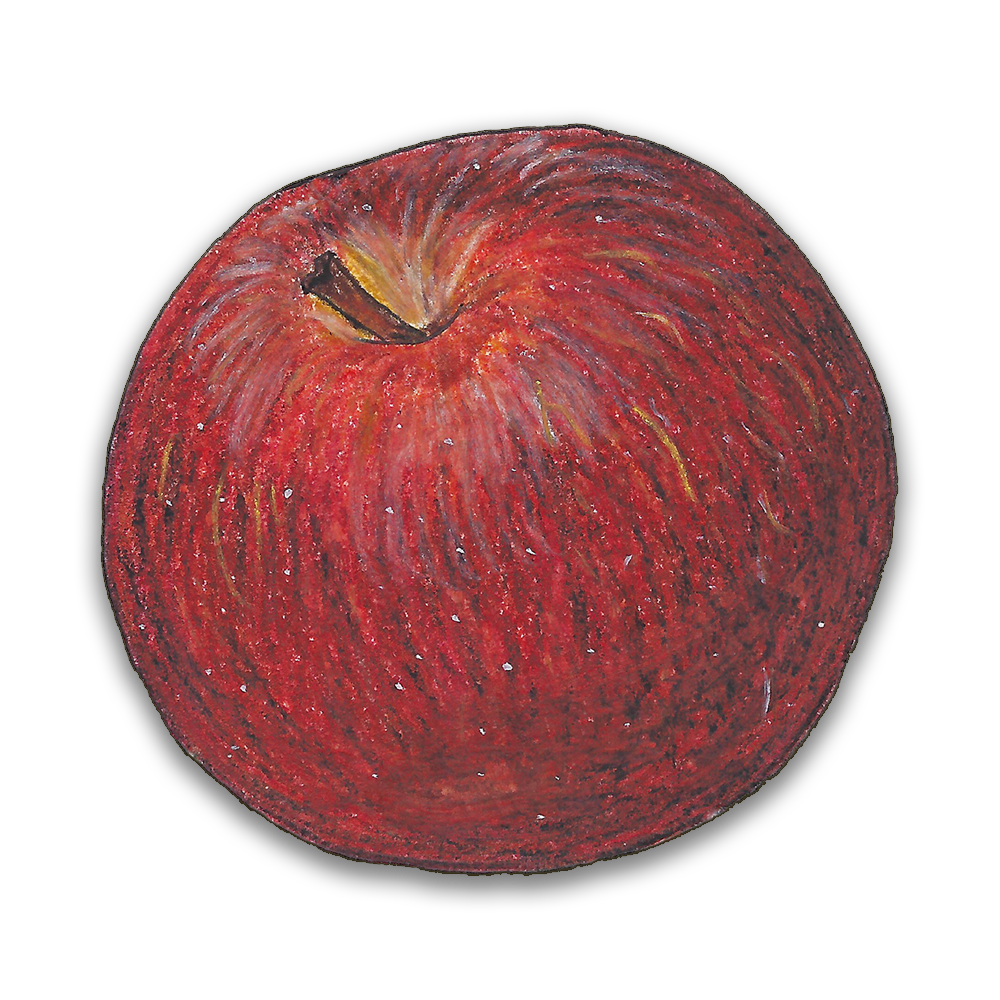
ROME BEAUTY
- Mid-October
- ORIGIN: Rome Township, Ohio, 1817
- PROFILE: Rome Beauty is an heirloom American cooking apple. It’s very aromatic with a mild sweetness, holding its shape when baked into a pie or crisp. Though it certainly is alright for eating, you have to catch them when they are perfectly ripe. They have a thick skin and can become mealy when stored for too long. This apple is a brilliant red with freckles and a smooth skin.
- USES: It’s optimal uses are for baking and cider. It’s also great for cooking and drying.




